Edwardian diamond rings
Edwardian engagement ring inspiration and information
Edwardian vintage rings are perfect for brides who favor delicate-looking, feminine engagement rings.
Resplendent with filigree work and glittering patterns of diamonds, Edwardian rings evoke a nostalgic air of gentility.

Think Audrey Hepburn in My Fair Lady and you’ll have an idea of the dress and jewelry of the Edwardian Age and why brides fall in love with its grace and style.
The Edwardian period
The Edwardian Period (1901-1910), sometimes called Belle Epoque, or The Beautiful Age, features jewelry that is light and airy.
Named for the English king, Edward VII, jewelers of the day took their cues from Edward’s beautiful, trend-setting wife, Alexandra, who exuded feminine grace. Almost as a revolt against the dark, heavy jewelry of the Victorian Era that precedes it, Edwardian jewelry is ethereal, light, and elegant.

The invention of the oxyacetylene torch, which reached incredibly high temperatures, enabled jewelers to manipulate platinum in the manufacturing of jewelry. An incredibly strong metal, platinum could be used to create the lacy, delicate styles of the Edwardian Age while still safely anchoring the numerous diamonds that were woven into the piece.

The common motifs of Edwardian jewelry are textile in nature. Garlands, flowers, bows, lace, and tassels were common designs and the era is sometimes called The Garland Era for its wide-spread use of the garland motif.
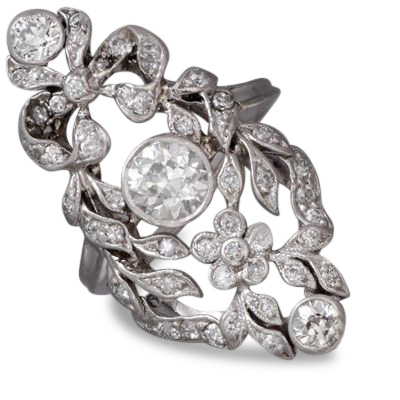
Antique Edwardian Engagement Rings
The word ‘antique’ is used to signify jewelry that’s 100 years or older, while the term ‘vintage’ usually refers to rings from a certain design period, like from the Art Deco Period or the Art Nouveau Period.
Edwardian engagement rings are elegant and delicate. They feature heavy accents of milgrain, filigree, and engraving. The mountings are often studded with smaller diamonds and gemstones of various sizes in order to provide a sparkling accompaniment to the center diamond.
- Milgrain – tiny metal beads along the edge of settings
- Filigree – delicate open scroll work and lacy flourishes
- Engraving – intricate carvings in the metal
This Edwardian ring shows a close-up of the milgrain beads, the open filigree work, and the engraving along the shank of the ring:

Image: Erstwhile Jewelry
This ring shows the feminine garland style and scrolled filigree work. The milgrain accents are throughout.

Pavé Edwardian ring settings
In keeping with the Edwardian style that called for diamonds, diamonds, and more diamonds, pavé settings were the perfect way for Edwardian jewelers to showcase multiple diamonds throughout their delicate mountings.
Pavé settings have tiny prongs holding small diamonds very close together creating a paved path of diamonds. The diamonds often shared prongs enabling them to be set even closer together.

Image: Erstwhile Jewelry
Bezel Edwardian Diamond Ring Settings
Bezel style settings of today seem sleek and modern, but this setting style is actually one of the oldest styles. The bezel setting is a thin wall of metal that runs the circumference of the diamond.
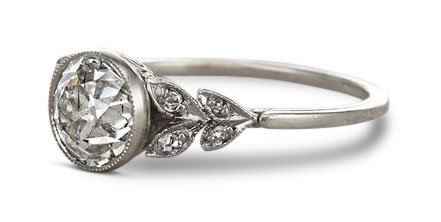
Image: Erstwhile Jewelry
The ring above shows the centered diamond in a bezel style settings with milgrain accenting the rim of the bezel. The mounting of the ring has the garland style popular with Edwardian engagement rings.
Cluster Settings

While diamond rings with a large, center diamond were popular, so were rings that displayed multiple diamonds. These rings were often in oval or navette shapes. A navette (which means ‘little ship’ in French) is narrow at opposite ends and bowed in the middle, like a boat or an American football

Edwardian knife edge ring settings
Intended to make the diamond appear as to be held by a thin wire, the knife edge setting has the mounting pinched to produce a ridge around the diameter of the shank.
This ring also has pave set diamonds aligned on each side of the knife edge.
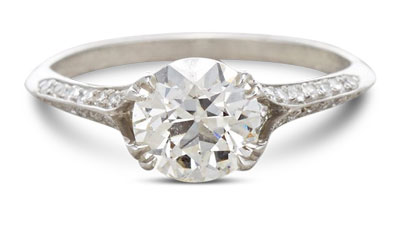
Image: Erstwhile Jewelry
Common diamond cuts in the Edwardian period
As you can probably imagine, Technology for cutting and shaping diamonds was much more basic than jewelers have access to today.
This means that jewelers were restricted to cutting simpler shapes, and could be less precise with their cutting.
In addition, antique Edwardian diamonds were cut at a time when the diamond cutters didn’t fully understand how to use light to generate maximum sparkle. As a result, many Edwardian diamonds have a smaller table than modern diamonds, which don’t let as much light enter the stone and as a result they don’t generate as much brilliance as a modern diamond.
Old Mine Cut diamond

Image: Erstwhile Jewelry
This diamond cut is older cousin of the modern round brilliant cut, but it’s most commonly compared to today’s cushion cut diamond due to the fact that it’s a rounded square.

Old mine cut diamonds were popular in the Edwardian Era because they allowed the diamond cutters to savie as much weight as possible from the diamond’s original crystal (called a rough) in order to yield the largest diamond.
As diamon crystals are generally square, this resulted in the square shaped old mine cut. Old Mine cut diamonds (called ‘miners’) are deep with a small table (top facet) and a large culet (facet at the point).
Old European Cut
The Old European cut diamond is the result of diamond cutter’s adapting new technology to their trade and cutting rounder diamonds.

For generations, diamond cutting was done by hand. In the wake of the Industrial Revolution, diamond cutters were able to produce rounder and more brilliant diamonds with modern technology. The Old Mine and the Old European cut diamond are both precursors to the modern round brilliant cut.
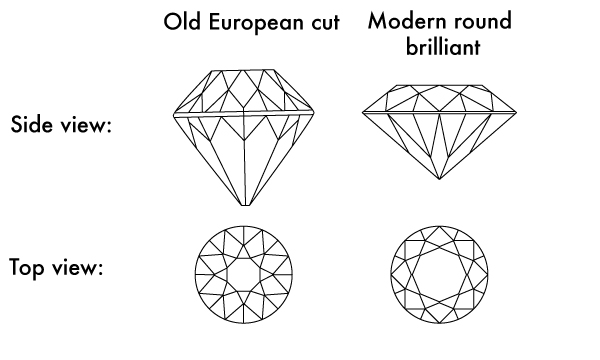
The Old European is rounder and deeper than the miners, but they still have the small table and large culet. The Old European cut has the same number of facets as the modern round brilliant cut. However, the round brilliant cut is more proportional in order to exact maximum light return.
Marquise Cut
The marquise cut diamond was a popular center diamond in Edwardian engagement rings. As we reviewed earlier, the navette shape in general was popular, so naturally the marquise shape would have had its heyday in the Edwardian Era.

Image: Erstwhile Jewelry
The marquise shape is a brilliant cut diamond. Brilliant cut diamonds have multiple facets that radiate out from the center of the diamond in contrast to step cut diamonds which have long, linear facets, like the emerald cut.
Cuts for Accent Diamonds and Gemstones
Scattered throughout Edwardian rings were smaller accent diamonds and gemstones.
Calibre cut gems are gemstones cut specifically for the piece. These can be any shape, depending on what is required to fit within the space. In the ring below, you can see calibre cut sapphires cut to fit the halo and frame the diamonds:

Gemstones used in Edwardian rings
While diamonds were used liberally and abundantly in Edwardian rings, brightly coloured gemstones were also featured prominently.
Pastel coloured gemstones were popular, especially amethysts and kunzite as purple and pink were the favorite colours of the trend-setting Princess Alexandra.
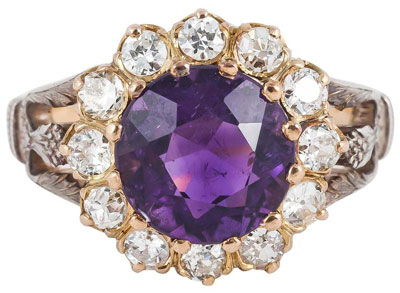
Natural pearls were viewed as a sign of wealth and purity and were used abundantly in Edwardian rings, necklaces, and earrings.

However, the beautiful Edwardian engagement rings were often accented with the vivid colours of the big three – ruby, sapphire, and emerald.

Image: Erstwhile Jewelry
This ring displays the filigree lattice work for which the Edwardian Era is known. The sapphires are caliber cut specifically for this ring.
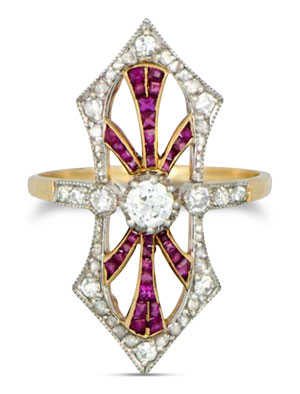
This ruby ring features platinum as a setting for the diamonds and 18k yellow gold as a setting for the rubies. The metal contrast is striking and the combination enhances the white of the diamonds and the red of the rubies. This metal mixture is a testimony to the artistic skill of Edwardian jewelers.
Sometimes, the gemstones were featured in the ring with numerous amounts of diamonds providing the accents.

This oval sapphire ring features the garland motif that was popular during the Edwardian Period along with the bezel settings and milgrain accents.
Emeralds were extremely popular along with other green gems, like demantoid garnet and peridot, because green was a favorite colour of King Edward.

Image: Erstwhile Jewelry
Edwardian Engagement Ring Metals
The beautiful artistry of Edwardian jewelry has yet to be rivaled even by today’s standards.
Platinum Edwardian engagement ring settings
In order to achieve the delicate looks of the Edwardian Era, the extremely durable metal, platinum, was used prolifically.
In addition, the pastel and white colours of women’s clothing called for white diamonds and white metals and platinum fit the bill on all counts.

This ring features the motifs and craftsmanship that make Edwardian style rings sought after to this day. The fine lattice filigree is throughout the ring while the garland accents highlight the bezel set Old European diamond in the center. The frame of pave set diamonds runs the perimeter of the jeweler’s artwork.
Gold edwardian engagement ring settings
While platinum was the darling metal of the era, gold wasn’t forgotten. The platinum was functional for its strength, but gold was used to provide a rich accent to pieces and was often overlaid on the platinum or used in conjunction with the platinum. Gold of 10k to 18k was common.

This ring combines the richness of 18k with the durability of platinum, which also highlights the whiteness of the diamonds.
Coloured gold was also popular in the Edwardian Era. This ring features an oval aquamarine in a filigree mounting of rose, green, and yellow gold. The pinks and greens of the gold add texture to the garland and flower motifs.

Naturally occurring gold is soft and a reddish yellow colour. To be used in jewelry, pure gold is strengthened by adding alloys to it. By adding specific alloys, the colour of the gold can be altered. Adding copper as an alloy turns the gold pink or rose coloured. Adding nickel produces the popular white gold while green gold is produced by adding silver.
Buying an Antique Edwardian Ring
Edwardian engagement rings
Vintage diamond ring inspiration and information
Edwardian vintage rings are perfect for brides who favor delicate-looking, feminine engagement rings.
Resplendent with filigree work and glittering patterns of diamonds, Edwardian rings evoke a nostalgic air of gentility.
Think Audrey Hepburn in My Fair Lady and you’ll have an idea of the dress and jewelry of the Edwardian Age and why brides fall in love with its grace and style.
Read on, and you’ll learn:
- The design motifs of the era
- Ring details
- Ring setting styles
- Diamond shapes
- Metals used
- Tips for buying an Edwardian rings

The Edwardian period
The Edwardian Period (1901-1910), sometimes called Belle Epoque, or The Beautiful Age, features jewelry that is light and airy.
Named for the English king, Edward VII, jewelers of the day took their cues from Edward’s beautiful, trend-setting wife, Alexandra, who exuded feminine grace. Almost as a revolt against the dark, heavy jewelry of the Victorian Era that precedes it, Edwardian jewelry is ethereal, light, and elegant.

The invention of the oxyacetylene torch, which reached incredibly high temperatures, enabled jewelers to manipulate platinum in the manufacturing of jewelry. An incredibly strong metal, platinum could be used to create the lacy, delicate styles of the Edwardian Age while still safely anchoring the numerous diamonds that were woven into the piece.

The common motifs of Edwardian jewelry are textile in nature. Garlands, flowers, bows, lace, and tassels were common designs and the era is sometimes called The Garland Era for its wide-spread use of the garland motif.

Antique Edwardian Engagement Rings
The word ‘antique’ is used to signify jewelry that’s 100 years or older, while the term ‘vintage’ usually refers to rings from a certain design period, like from the Art Deco Period or the Art Nouveau Period.
Edwardian engagement rings are elegant and delicate. They feature heavy accents of milgrain, filigree, and engraving. The mountings are often studded with smaller diamonds and gemstones of various sizes in order to provide a sparkling accompaniment to the center diamond.
- Milgrain – tiny metal beads along the edge of settings
- Filigree – delicate open scroll work and lacy flourishes
- Engraving – intricate carvings in the metal
This Edwardian ring shows a close-up of the milgrain beads, the open filigree work, and the engraving along the shank of the ring:

Image: Erstwhile Jewelry
This ring shows the feminine garland style and scrolled filigree work. The milgrain accents are throughout.

Pavé Edwardian ring settings
In keeping with the Edwardian style that called for diamonds, diamonds, and more diamonds, pavé settings were the perfect way for Edwardian jewelers to showcase multiple diamonds throughout their delicate mountings.
Pavé settings have tiny prongs holding small diamonds very close together creating a paved path of diamonds. The diamonds often shared prongs enabling them to be set even closer together.

Image: Erstwhile Jewelry
Bezel Edwardian Diamond Ring Settings
Bezel style settings of today seem sleek and modern, but this setting style is actually one of the oldest styles. The bezel setting is a thin wall of metal that runs the circumference of the diamond.

Image: Erstwhile Jewelry
The ring above shows the centered diamond in a bezel style settings with milgrain accenting the rim of the bezel. The mounting of the ring has the garland style popular with Edwardian engagement rings.
Cluster Settings

While diamond rings with a large, center diamond were popular, so were rings that displayed multiple diamonds. These rings were often in oval or navette shapes. A navette (which means ‘little ship’ in French) is narrow at opposite ends and bowed in the middle, like a boat or an American football

Edwardian knife edge ring settings
Intended to make the diamond appear as to be held by a thin wire, the knife edge setting has the mounting pinched to produce a ridge around the diameter of the shank.
This ring also has pave set diamonds aligned on each side of the knife edge.

Image: Erstwhile Jewelry
Common diamond cuts in the Edwardian period
As you can probably imagine, Technology for cutting and shaping diamonds was much more basic than jewelers have access to today.
This means that jewelers were restricted to cutting simpler shapes, and could be less precise with their cutting.
In addition, antique Edwardian diamonds were cut at a time when the diamond cutters didn’t fully understand how to use light to generate maximum sparkle. As a result, many Edwardian diamonds have a smaller table than modern diamonds, which don’t let as much light enter the stone and as a result they don’t generate as much brilliance as a modern diamond.
Old Mine Cut diamond

Image: Erstwhile Jewelry
This diamond cut is older cousin of the modern round brilliant cut, but it’s most commonly compared to today’s cushion cut diamond due to the fact that it’s a rounded square.

Old mine cut diamonds were popular in the Edwardian Era because they allowed the diamond cutters to savie as much weight as possible from the diamond’s original crystal (called a rough) in order to yield the largest diamond.
As diamon crystals are generally square, this resulted in the square shaped old mine cut. Old Mine cut diamonds (called ‘miners’) are deep with a small table (top facet) and a large culet (facet at the point).
Old European Cut
The Old European cut diamond is the result of diamond cutter’s adapting new technology to their trade and cutting rounder diamonds.

For generations, diamond cutting was done by hand. In the wake of the Industrial Revolution, diamond cutters were able to produce rounder and more brilliant diamonds with modern technology. The Old Mine and the Old European cut diamond are both precursors to the modern round brilliant cut.

The Old European is rounder and deeper than the miners, but they still have the small table and large culet. The Old European cut has the same number of facets as the modern round brilliant cut. However, the round brilliant cut is more proportional in order to exact maximum light return.
Marquise Cut
The marquise cut diamond was a popular center diamond in Edwardian engagement rings. As we reviewed earlier, the navette shape in general was popular, so naturally the marquise shape would have had its heyday in the Edwardian Era.

Image: Erstwhile Jewelry
The marquise shape is a brilliant cut diamond. Brilliant cut diamonds have multiple facets that radiate out from the center of the diamond in contrast to step cut diamonds which have long, linear facets, like the emerald cut.
Cuts for Accent Diamonds and Gemstones
Scattered throughout Edwardian rings were smaller accent diamonds and gemstones.
Calibre cut gems are gemstones cut specifically for the piece. These can be any shape, depending on what is required to fit within the space. In the ring below, you can see calibre cut sapphires cut to fit the halo and frame the diamonds:

Gemstones used in Edwardian rings
While diamonds were used liberally and abundantly in Edwardian rings, brightly coloured gemstones were also featured prominently.
Pastel coloured gemstones were popular, especially amethysts and kunzite as purple and pink were the favorite colours of the trend-setting Princess Alexandra.

Natural pearls were viewed as a sign of wealth and purity and were used abundantly in Edwardian rings, necklaces, and earrings.

However, the beautiful Edwardian engagement rings were often accented with the vivid colours of the big three – ruby, sapphire, and emerald.

Image: Erstwhile Jewelry
This ring displays the filigree lattice work for which the Edwardian Era is known. The sapphires are caliber cut specifically for this ring.

This ruby ring features platinum as a setting for the diamonds and 18k yellow gold as a setting for the rubies. The metal contrast is striking and the combination enhances the white of the diamonds and the red of the rubies. This metal mixture is a testimony to the artistic skill of Edwardian jewelers.
Sometimes, the gemstones were featured in the ring with numerous amounts of diamonds providing the accents.

This oval sapphire ring features the garland motif that was popular during the Edwardian Period along with the bezel settings and milgrain accents.
Emeralds were extremely popular along with other green gems, like demantoid garnet and peridot, because green was a favorite colour of King Edward.

Image: Erstwhile Jewelry
Edwardian Engagement Ring Metals
The beautiful artistry of Edwardian jewelry has yet to be rivaled even by today’s standards.
Platinum Edwardian engagement ring settings
In order to achieve the delicate looks of the Edwardian Era, the extremely durable metal, platinum, was used prolifically.
In addition, the pastel and white colours of women’s clothing called for white diamonds and white metals and platinum fit the bill on all counts.

This ring features the motifs and craftsmanship that make Edwardian style rings sought after to this day. The fine lattice filigree is throughout the ring while the garland accents highlight the bezel set Old European diamond in the center. The frame of pave set diamonds runs the perimeter of the jeweler’s artwork.
Gold edwardian engagement ring settings
While platinum was the darling metal of the era, gold wasn’t forgotten. The platinum was functional for its strength, but gold was used to provide a rich accent to pieces and was often overlaid on the platinum or used in conjunction with the platinum. Gold of 10k to 18k was common.

This ring combines the richness of 18k with the durability of platinum, which also highlights the whiteness of the diamonds.
Coloured gold was also popular in the Edwardian Era. This ring features an oval aquamarine in a filigree mounting of rose, green, and yellow gold. The pinks and greens of the gold add texture to the garland and flower motifs.

Naturally occurring gold is soft and a reddish yellow colour. To be used in jewelry, pure gold is strengthened by adding alloys to it. By adding specific alloys, the colour of the gold can be altered. Adding copper as an alloy turns the gold pink or rose coloured. Adding nickel produces the popular white gold while green gold is produced by adding silver.
Buying an Antique Edwardian Ring
If you are interested in an authentic Edwardian engagement ring, there are many on-line antique dealers who can help you shop. Even though there are many antique dealers on the internet, shop with stores that specialize in antique jewelry who employ gemologists. In addition to being knowledgeable about the Edwardian Period, these antique dealers can also educate you about other design periods that may interest you.
Also, reputable antique dealers know that each vintage piece is unique and that pictures don’t always capture the piece accurately. Therefore, dealers usually have a return policy in place if you are not satisfied with your item. If this is the case, I recommend calling the dealer immediately after receiving the item to alert them that you are not happy. They usually have a specified number of days when you must return the item for a refund.
Difficulty resizing
Rings can only be sized larger or smaller to certain sizes until the integrity of the ring becomes compromised. In addition, many Edwardian rings have hand engraving along the metal and sizing could remove the designs.
More fragile
These are antiques which means they will have wear on them. Prongs could be thin and may need re-tipped. Also, the gemstones could have some abrasions and chipping from years of wear by previous owners.

Diamonds aren’t as brilliant
As we reviewed in the cut styles, diamonds weren’t cut to the precise proportions to produce maximum brilliance like they are today. The diamonds in Edwardian rings will be less sparkly.

Diamond grading
Many diamonds will not have an diamond grading report. The GIA will not grade a mounted diamond and removing a diamond from its setting could damage the historical correctness of the piece.
My recommendation
If you like the look of authentic Edwardian rings, but aren’t keen on the issues we highlighted, you could opt for a reproduction ring. A reproduction ring is a modern ring fabricated to emulate the style of Edwardian ring, with modern levels of materials and craftsmanship.
My recommendation here is London Victoria Ring Co. who produce authentic original Edwardian designs with modern levels or workmanship, materials and service.
They will listen to your ideas, give you guidance, deliver incredible workmanship and stand behind their product with a level of service and value that you will rarely find in any arena.
If you’re looking for an Art Deco ring to wear every day, I recommend you check out London Victoria Ring Co’s selection of Edwardian styles.

